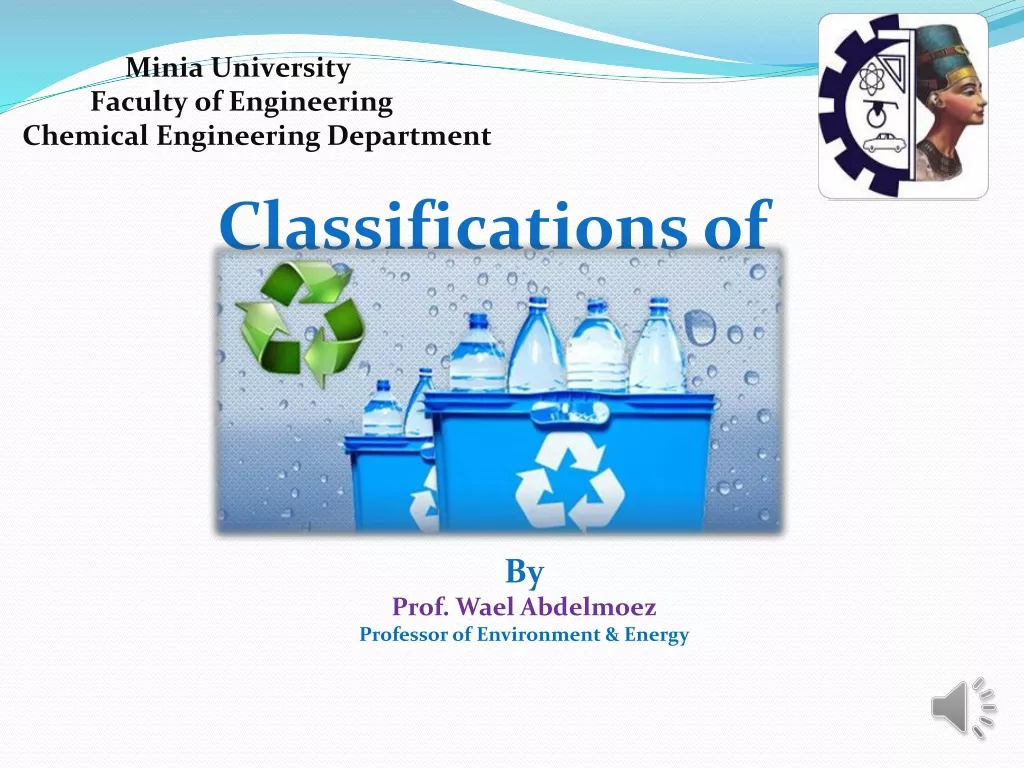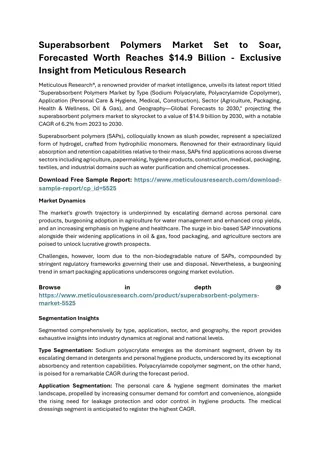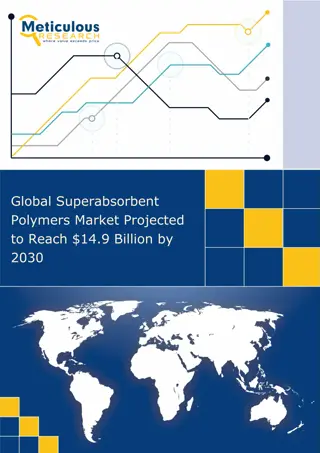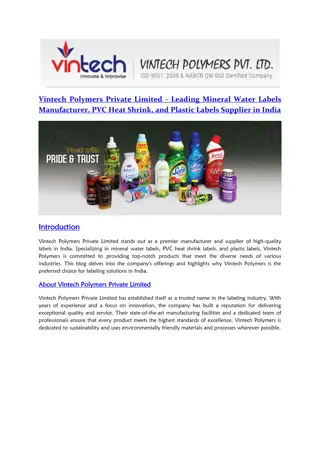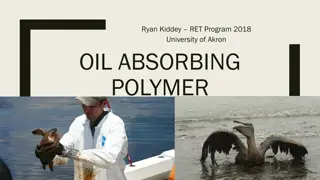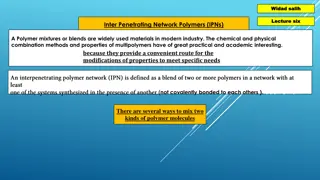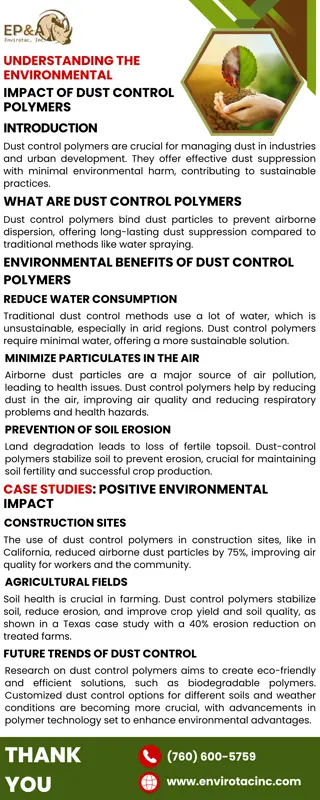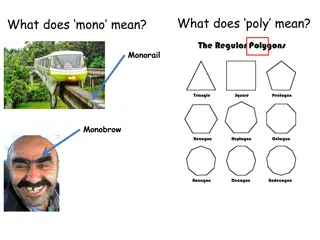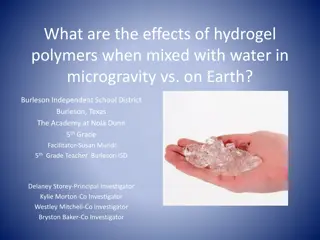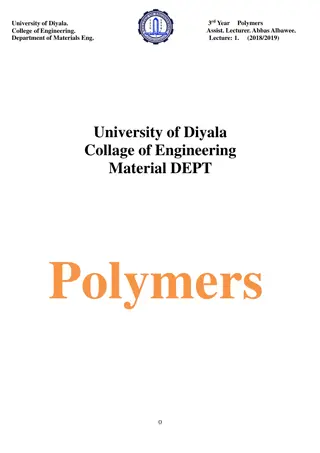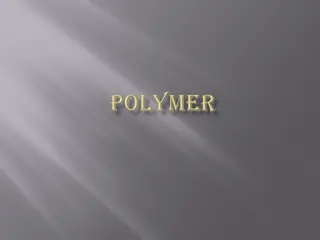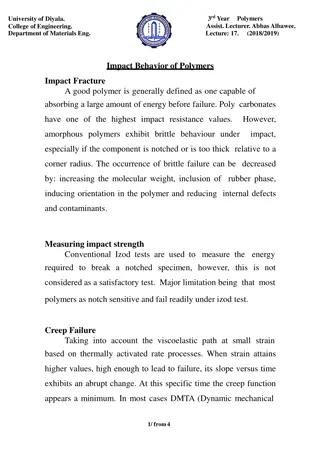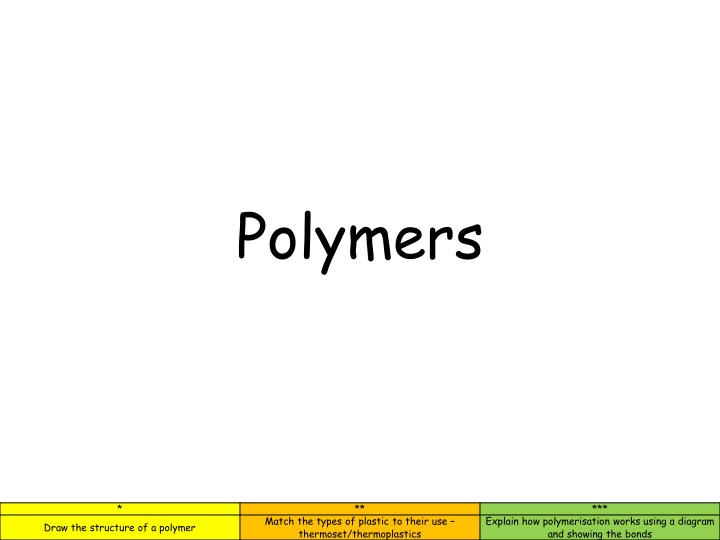
Polymers: Types, Uses, and Polymerization Process
Dive into the world of polymers, exploring the different types of plastics like thermoset and thermoplastics, understanding how polymerization works with detailed diagrams, and learning about the structure of polymers. Discover the importance of polymer chains in determining properties, and explore the factors affecting polymer behavior.
Download Presentation

Please find below an Image/Link to download the presentation.
The content on the website is provided AS IS for your information and personal use only. It may not be sold, licensed, or shared on other websites without obtaining consent from the author. If you encounter any issues during the download, it is possible that the publisher has removed the file from their server.
You are allowed to download the files provided on this website for personal or commercial use, subject to the condition that they are used lawfully. All files are the property of their respective owners.
The content on the website is provided AS IS for your information and personal use only. It may not be sold, licensed, or shared on other websites without obtaining consent from the author.
E N D
Presentation Transcript
Polymers * ** *** Match the types of plastic to their use thermoset/thermoplastics Explain how polymerisation works using a diagram and showing the bonds Draw the structure of a polymer
What are polymers? * ** *** Match the types of plastic to their use thermoset/thermoplastics Explain how polymerisation works using a diagram and showing the bonds Draw the structure of a polymer
What do we make polymers from? * ** *** Match the types of plastic to their use thermoset/thermoplastics Explain how polymerisation works using a diagram and showing the bonds Draw the structure of a polymer
What are the different types of polymer? * ** *** Match the types of plastic to their use thermoset/thermoplastics Explain how polymerisation works using a diagram and showing the bonds Draw the structure of a polymer
http://bpes.bp.com/secondary- resources/science/ages-14-to-16/chemical-and- material-behaviour/polymerisation/ * ** *** Match the types of plastic to their use thermoset/thermoplastics Explain how polymerisation works using a diagram and showing the bonds Draw the structure of a polymer
Polymers (Greek) poly= many meros= part Each polymer molecule is made from a repeating unit: a monomer Monomers are small molecules (not single atoms). polymerisation monomers Single polymer chain * ** *** Match the types of plastic to their use thermoset/thermoplastics Explain how polymerisation works using a diagram and showing the bonds Draw the structure of a polymer
Size and shape matter Polymer chains are like long bits of string. The polymer s properties depend on many factors: length of chains type of monomer(s) side-links and branches temperature time taken for polymer to cool down other chemicals present * ** *** Match the types of plastic to their use thermoset/thermoplastics Explain how polymerisation works using a diagram and showing the bonds Draw the structure of a polymer
Arrangement of the chains The length of the chain can be controlled. The chains are thousands or millions of units long. DNA: a very complex polymer up to 220 million units long. * ** *** Match the types of plastic to their use thermoset/thermoplastics Explain how polymerisation works using a diagram and showing the bonds Draw the structure of a polymer
Chain length They twist and bend and tangle with each other, but can also line up neatly. Chains aligned (crystalline) Chains entangled (amorphous) * ** *** Match the types of plastic to their use thermoset/thermoplastics Explain how polymerisation works using a diagram and showing the bonds Draw the structure of a polymer
Branching and cross-linking Sometimes they can have branches, or they can be linked to other chains. Different types of branching Cross-linked chains * ** *** Match the types of plastic to their use thermoset/thermoplastics Explain how polymerisation works using a diagram and showing the bonds Draw the structure of a polymer
Which of the following molecules could be used as monomers? Explain your answer. A B C * ** *** Match the types of plastic to their use thermoset/thermoplastics Explain how polymerisation works using a diagram and showing the bonds Draw the structure of a polymer
The solid lines represent covalent bonds. A thermosoftening plastic: A thermosetting plastic: Note: Polyethene is a thermoplastic plastic. Bakelite is a thermosetting plastic. Use the diagrams to explain the following observations. Polyethene is flexible Bakelite is rigid Polyethene melts when heated. Bakelite does not melt when heated Use Thermoplastic or thermosetting plastic? Ash tray Carrier bag Electric plug Packaging * ** *** Match the types of plastic to their use thermoset/thermoplastics Explain how polymerisation works using a diagram and showing the bonds Draw the structure of a polymer
Making slime PVA is a polymer We add borax which forms the borate ion in solution * ** *** Match the types of plastic to their use thermoset/thermoplastics Explain how polymerisation works using a diagram and showing the bonds Draw the structure of a polymer
The chemistry of slime What has happened to the PVA? How has the structure changed? * ** *** Match the types of plastic to their use thermoset/thermoplastics Explain how polymerisation works using a diagram and showing the bonds Draw the structure of a polymer
Polymers Putting all the information you know together, make a double spread page about polymers. Use connectives to improve the quality of writing and make your point. * ** *** Match the types of plastic to their use thermoset/thermoplastics Explain how polymerisation works using a diagram and showing the bonds Draw the structure of a polymer

